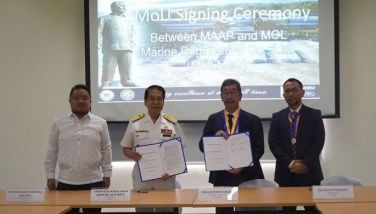Taking stock, looking forward
January 4, 2003 | 12:00am
 Another year has come and gone. It seems like only last week that we were reeling from the aftereffects of the twin terrors of 9/11 and continuing economic recession of 2001. We end this year still feeling the effects of the continuing threat of terror and a looming war in the Middle East. We have coped valiantly with the recession but we now face the prospect of less-than-wonderful economic performance because of increasing election-related politics.
Another year has come and gone. It seems like only last week that we were reeling from the aftereffects of the twin terrors of 9/11 and continuing economic recession of 2001. We end this year still feeling the effects of the continuing threat of terror and a looming war in the Middle East. We have coped valiantly with the recession but we now face the prospect of less-than-wonderful economic performance because of increasing election-related politics.
It’s time to take stock and figure out how we can cope further. I’ve looked back at the previous year’s 50 essays or so of "City Sense" to figure out what we’ve covered together and what would be of interest or of relevance to readers in 2003. (Many people ask me if I ever run out of things to write about. I answer that I’ve just scratched the surface as we have many issues regarding urbanism and architecture that never get written about and we have thousands of heritage sites and landmarks that need saving!)
Speaking of landmarks, we featured many last year. I enjoyed looking at the old National Press Club, the original Architectural Center Bldg, the Lyceum, Manila’s original high-rise apartments and forgotten triumphal arches. Also featured were Malacañang Palace and Silliman University. Many readers wrote back to inquire about details of these buildings or to share their own anecdotes.
Last year, there were a number of essays on urbanism and city life …or at least suburban life. "Life in Suburbia" and "My Own Personal Quezon City" were pieces that were a little like auto-ethnographies of Filipino urban life. Next year, I do hope to continue writing about our evolving urbanism and new options and forms of urban, suburban and exurban (really far-flung areas) areas of growth.
Back to landmarks and landmark sites. We featured some of those public places the city is slowly losing as well as those that have been partially recovered. Early in the year, I wrote a piece on Plaza Calderon de la Barca. This famous and historic plaza in Binondo has now deteriorated into a laundry-drying area and temporary homeless shelter. We also looked at the recovery of Plaza Lawton (Liwasang Bonifacio) – a laudable effort by the otherwise heritage-insensitive Manila administration. On this particular project they were assisted by several NGOs including the Heritage Conservation Society.
Sure, Mayor Atienza should be congratulated for his efforts in Malate and Roxas Boulevard but it is all these other sites of heritage and open green space (some of which are not under his direct control) that need to be saved and given back to the people. Manila and the rest of the metropolis still lack a comprehensive and sustainable master plan for parks, plazas and open green spaces.
The column has also featured other parts and landmarks of the city. We featured the Ang Tibay factory, a legacy of Toribio Teodoro, legendary Filipino industrialist. Ang Tibay shoes were renowned for their durability and looks. It took years to wear them out or they were passed on once outgrown. Ang Tibays were so good that they were even exported. How are our own products doing on the world market now? While shopping this season, I found little that was still made here. Almost everything sold is made elsewhere – therefore the profits ultimately go outside too.
Other landmarks we looked at were the SSS building and other structures of that era. Few of today’s modern structures are completely Filipino-designed and constructed. Clients now favor foreign consultants to our very own. With the construction industry making a comeback, the same situation may lead to a dearth of commissions for Filipino designers. Yet it is Filipino talent that shines abroad. World-class structures in Singapore, Hong Kong, Kuala Lumpur, the Middle East and now even in the United States – all have Filipino designers behind their design and construction.
It is important that we also look at where design – as Filipino architects, landscape architects, interior designers and graphic designers have been doing– has gone and where it is headed. This, to counter the effects of globalization and hence to find one more anchor lest we be swept away in the deluge of homogenized culture and consumption.
2003 should be a year of taking stock. We must anticipate and believe that things will get better. Giving up is not an option. We are all in this for the long run – whatever our religion, social class or political bent (well, maybe we should straighten out our political bent so that we do make a difference).
Please let me know what other landmarks you see should be conserved, what other green spaces are disappearing, what other options we should look at to "fix" our urban problems. Chairman Bayani Fernando of the MMDA says that he is open to suggestions from the public. It is only an enlightened and educated public that can set its own course to progress and salvation. We should never give up and never surrender.
Yes, 2003 can and will be a good year. Y’all have a good one!
BrandSpace Articles
<
>



















